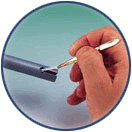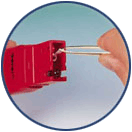|
Calibration
of a pH meter with its probe
All
pH meters need to be calibrated periodically. To know
how often you should calibrate your pH meter, click
here.
As
all pH meters have different features (automatic calibration,
manual calibration, auto buffer recognition, etc.),
the best calibration explanation of your Hanna meter
is in the instruction manual. If you no longer have
the instruction manual, you can download a copy by clicking
here.
General procedure
If
your pH electrode is new or has not been used for a
while, proceed with conditioning of your pH electrode
prior to use (store overnight into HI 70300L storage
solution).
Dip your pH electrode into HI 7007L pH 7.01 buffer first.
Wait for the reading to stabilize and adjust the pH
meter to read 7.01 on the display.
Rinse the pH electrode with distilled or tap water.
Dip the pH electrode into HI 7004L pH 4.01 or HI 7010L
pH 10.01 buffer and wait for the reading to stabilize.
Then adjust to read accordingly. Calibration is done
and your meter is ready to use.
Note: Always
start calibrations at pH 7 first and 4 or 10 second.
The choice of the second buffer depends on your application:
if you measure values below pH 7, use pH 4 as a second
buffer. If you measure values above pH 7, use pH 10
as your second buffer. Some of our pH meter use 3 points
calibration, keep in mind to always start with pH 7
first and others after.

Verification of a pH electrode
First
look for scratches on sensor (glass bulb). If the sensor
seems to be OK, make sure your pH sensor is well conditioned
(soak sensor into HI 70300L storage solution overnight).
When conditioning is completed, dip your electrode into
pH 7 and wait for the reading to stabilize (If it does
not stabilize, perform a cleaning procedure). Adjust
the reading to read 7.0 pH. If you can not reach the
value (reading higher than 8.2 or lower than 5.8) do
a cleaning procedure. When able to adjust to 7.0, switch
to mV readings on your pH meter. You should have a reading
of 0.0mV, ± 30mV. If the reading is higher than ± 50mV,
you need to replace the electrode. If reading is below
50mV, proceed to rinse electrode with distilled or tap
water and dip into pH 4 or pH 10 buffer. Switch in pH
measurement mode and wait for the reading to stabilize.
Adjust the reading to read 4.0 pH. If you can not reach
the value (reading higher than 5.0 or lower than 3.0)
do a cleaning procedure. When able to adjust to 4.0,
switch to mV readings on your pH meter. You should have
a reading of 180mV, ± 30mV. If the reading is higher
than ± 50mV, you need to replace the electrode.

Cleaning & storage of a pH electrode
Note:
By cleaning the electrode with the help of the proper
cleaning solution, you insure optimum results and longer
life to your valuable instrument.
| Product |
Application |
| HI
7061 |
Cleaning
Solution for General Use
This solution can be used for about any applications.
It is not aggressive, so you should use it regularly
and your electrode will be ready whenever you
need to use it.
Cleaning time: 30 minutes to 1 ½ hour
Frequency: Once or twice a month or more depending
on application |
| HI
7073 |
Cleaning
Solution for Protein
This cleaning solution will stop the problem of
having junction clogged with protein. The only
thing you have to do is dip the tip of the electrode
for 15 minutes, each time the response time begins
to slow down.
Use 1g. of the powder for each 100 ml of solution. |
| HI
7074 |
Cleaning Solution for Inorganic
Substances
This solution is especially made for inorganic
substances but will be very effective in other
applications as well. It is usually used in industrial
applications. Probably the fastest cleaning solution
you can use.
Cleaning time: 5 to 15 minutes
Frequency: Once or twice a month or more depending
on application |
| HI
7077 |
Cleaning
Solution for Oils
An oily or greasy substance makes usually a difficult
task for taking pH from sample to sample without
contaminating the next one (because oils and greases
are difficult to rinse with water). By rinsing
the electrode with the HI 7077 and with distilled
water after each measurement, you will be ready
for the next sample
|
Storage
of pH electrode
AFTER USE: Always
clean the pH electrode with plenty of clean water and
store it in the storage solution (fill the cap with
storage solution and put it back on). Verify the level
regularly, as the solution will evaporate. Whenever
you need to take measurements, the pH electrode will
be ready to use as it will already be conditioned.

How to use replenishable junction
Over time, the junction which is the most sensitive
part of the pH electrode can become clogged. This results
in the electrode response becoming increasingly sluggish
and eventually impossible to calibrate. With the new
Hanna replenishable junctions, by using an ordinary
pair of tweezers, simply pull out 1-2mm (1/8’’) of the
fiber junction and you will literally have a reconditioned
pH electrode. This procedure can be repeated up to 15
times, before the whole fiber gets out.



|

